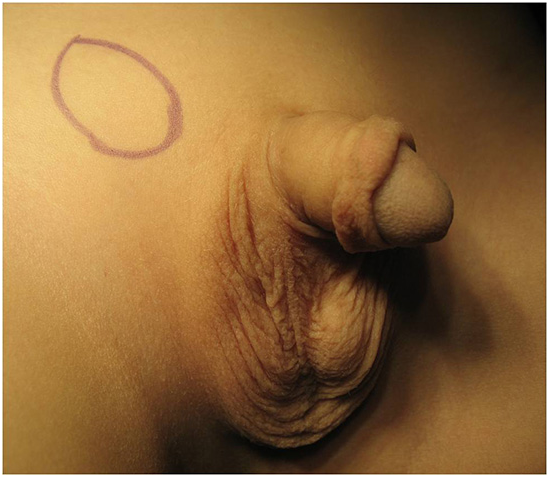İnmemiş Testis
Doğan her yüz erkek bebeğin birinde görülen inmemiş testis, erken müdahale gerektiren bir hastalık. Çünkü zamanında yapılmayan tedavi, kısırlıktan kansere kadar birçok ciddi sağlık sorunun da nedeni olabilir
Bilinen yaygın ismiyle yumurtalıklar (testis), erkeklerde gelişmeyi sağlayan hormonları salgıladığı gibi, sperm de üreten bir organdır. Ergenlikle birlikte artan hormon salınımı ve sperm üretimi yaşam boyunca sürer. Testislerin görevini yerine getirebilmesi için vücut dışında yani torbaların içinde bulunması gerekir ki, burada sıcaklık yaklaşık 35.5 derecedir. Vücudumuzun koltuk altından ölçüldüğünde 36.5 derecelik ısısı, ağızdan veya rektal derece ile bakıldığında yaklaşık 37.5 derecedir ki bu da testisin normal işlevi için yüksektir.
İnmemiş Testis nedir?
Yeni doğmuş erkek çocuğun testislerinin torbada (skrotum) olmaması durumuna inmemiş testis adı verildi. Bu bebeklerin çoğunda genellikle tek tarafında inmemiş testis gözlenir. Ancak bazı bebeklerde her iki testis torbası da boş olabilir. Bu durumda önemli olan nokta; tek ya da çift taraflı da olsa, testislerin hiçbir zaman torbada bulunmamasıdır.
Torbada olmayan testisler nerede bulunur? Bebekler, anne karnındayken karın zarı arka kısmında, böbreklere yakın bir yerleşimdedir. Bebeğin gelişimiyle beraber, karın boşluğunda bulunan testisler de 7. Aydan sonra torbaya doğru inmeye başlar. Doğuma yaklaşıldığı süreçte, torbaya doğru ilerleyen testisler, kasık kanalını aşar ve torbaya yerleşir. Ancak bu hareket bazı bebeklerde doğumdan sonra da devam edebilir. Bazı bebeklerde doğduktan sonra 6 ay içinde testisinin yerleştiğini gözlemleriz. 6 aydan sonra yerleşmesi pek mümkün değildir.
İnmemiş testis erkeklerde en sık görülen cinsellikle ilgili doğumsal anomalidir. Her 100 bebekten birinde görülür.. Vaktinden önce doğan bebeklerde inmemiş testis görülme ihtimali, vaktinde doğmuş bebeklere göre 3 kat fazladır. Bunun nedeni de; testisler hamileliğin 8. ayında testisin yerine yerleşmesinin sekteye uğraması.
İnmemiş testisin nedenleri
Testisin kendisinden kaynaklanan iç bozukluklar, hormonal etkiler, genetik bozukluk gibi nedenler öne sürülmekle birlikte kesin bir sebep gösterilmemektedir
İnmemiş testisten farklı olarak, görülen bir durum vardır ki, halk arasında bilinen tanımıyla ‘utangaç testis’ olarak adlandırılır. Tıbbi adıyla “Retraktil” denilen utangaç testisi olan bebeklerde, testisler bazen trbada bulunur. Torbada olmadığı zamanlarda ise, kasıklara doğru kaçar ve kaybolurlar. Bu durum, özellikle soğuğa maruz kaldığı zamanlarda ya da çocuğun testislerinin ellenmesi sırasında belirgin olarak fark edilir. Tam tersi durumda ise; örneğin, sıcak ortamda, çocuğun ateşinin çıktığı zamanlarda ya da çocuk uyurken testis tekrar torbaya yerleşir.
Utangaç testis, inmemiş testis gibi bir hastalık değil, masum bir durumdur. Bu çocukların inmemiş testis de olduğu gibi ilerdeki yaşamlarında herhangi bir sorun yaratmaz. Tedavi edilmesine gerek yoktur. Genellikle çift taraflı görülen utangaç testisler, ergenliğin erken döneminde tam olarak torbaya yerleşirler. Sık sık torbasından kaçmasına rağmen testisler, çoğu zaman torbada bulunduğu için normal sperm üretimlerine devam ederler. Ancak bu çocukların 6 aylık düzenli olarak muayene edilmesi uygundur.
Testis yok olabilir!
İnmemiş testisin tamamen ortadan kalktığı durumlar da söz konusu olduğunu söyleyebiliriz. Bazen karın içinden torbaya doğru ilerleyen testis, kendi etrafında döner ve bu dönme sırasında, testisi besleyen damarlar burulur ve dolayısıyla da tıkanır. Bir süre sonra çürümeye başlar. Bu bebekler, testisi olmadan doğarlar. Bu durum anne karnındayken gerçekleşir ve bir belirti vermez.
İnmemiş testis, elle yapılan bir muayene sonucu anlaşılır. Hasta bebeklerin yüzde 80’ne bu yöntemle teşhis konulur. Muayene sırasında, testis, kasık kanalı civarında olduğu görülür. Ancak bazı hasta bebeklerde kasık kanalında rastlanmadığı durumlar da söz konusudur. O zaman testisin, inişini tamamlayamayıp karın içinde kaldığı veya besleyen damarı ile ilgili bir problem gelişip testisin yok olduğu düşünülür. Ele gelmeyen testisi olan bir hastada testisin yerini belirlemek için önce görüntülemeler kullanılır. Bu şekilde anlaşılamadığı durumlar da olabilir.. Bu durumda başvurulacak en kesin tanı biçimi; laparoskopidir. Laparoskopi bebeğin karın duvarına küçük bir delik açılarak, bu delikten ince ve ışıklı bir mercek sokularak karnının içi incelenme esasına dayanır. İnceleme sırasında testisin yeri saptanır ve bazen bu işlem sırasında testis torbaya indirilebilir. Ancak testisin yok olduğu bir durum söz konusu ise o zaman çürüyen testis kalıntısı bulunur ve dışarı çıkarılır.
Erken tedavi
İnmemiş testise erken teşhis ve müdahale son derece önemlidir. Daha önce bahsedildiği gibi, bazı bebeklerde testislerin inmesi doğumdan sonraki ilk 6 aya kadar uzar. Bu nedenle müdahale zamanı, 6 ay ile 1 sene içinde olmalıdır. Tedavi, en geç 2 yaşında bitirilmelidir. Her hangi bir nedenle 2 yaşına kadar tespit edilmemiş çocuklarda, tespit edildiği zaman yapılması gerekir. 2 yaşından sonra çocuklarda geri dönüşümü olmayan olumsuz durumlar söz konusu olabilir. Özellikle erişkin yaşlarda sperm yapımında zayıflama ortaya çıkabilir. Başka bir riski ise, bu testislerde, yetişkinlik döneminde testis tümörünün gelişme oranının diğer erkeklere göre 4-5 kat artmasıdır.
İnmemiş testis bazen kasık fıtığı ile birlikte bulunur, bu durumda kasık fıtığına müdahale fıtık tespit edildikten sonra ilk fırsatta yapılması gerektiğinden, fıtığa müdahale edilirken testis de torbaya indirilip tespit edilir. Böyle bir durum saptandığı zaman, bebeğin 6 aydan küçük olması tedavinin ertelenmesi için gerekçe sayılmaz. Bebek yeni doğan bile olsa, müdahale yapılmalıdır.
Tedavi
İnmemiş testis rastlanan bebeklerin tedavisi için kesin olan yöntem ameliyattır. Bazı durumlarda örneğin retraktil testiste hormonal tedaviye başvurulabilir. Bu ameliyatlar, çocuk cerrahları ya da çocuk ürologları tarafından yapılmalıdır. Ameliyat ortalama 30 dakika sürer. İki gün sonra da günlük aktivitesine dönebilir. Ancak 20 gün, spor faaliyetlerine izin verilmez
İnmemiş testisin riskleri?
- Kısırlık nedeni olabilir. Testisin erken torbaya indirilmesi kısırlık riskinin düşürür.
- İnmemiş testis sorunu olanların ileriki yaşlarda, testislerinde kanser gelişme riski diğer erkeklere göre 15 kat fazladır.
- İnmemiş testis durumuna kasık fıtığı da eşlik edebilir.


